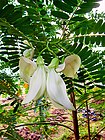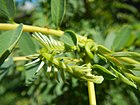Note: This is a project under development. The articles on this wiki are just being initiated and broadly incomplete. You can Help creating new pages.
Sesbania grandiflora
Sesbania grandiflora is a short-lived, soft-wooded, loosely-branching tree with a rather open crown. It can grow 8 - 15 metres tall. The straight, cylindrical bole can be 25 - 30cm in diameter. A true multi-purpose tree, providing a range of foods, medicines, timber, gum and tannins, mainly for local use. The plant is cultivated in many tropical areas as an ornamental, a green manure crop, in soil reclamation schemes and for its many useful properties. It is sold as a vegetable in local markets.
Contents
[hide]- 1 Uses
- 2 Parts Used
- 3 Chemical Composition
- 4 Common names
- 5 Properties
- 6 Habit
- 7 Identification
- 8 List of Ayurvedic medicine in which the herb is used
- 9 Where to get the saplings
- 10 Mode of Propagation
- 11 How to plant/cultivate
- 12 Commonly seen growing in areas
- 13 Photo Gallery
- 14 References
- 15 External Links
Uses
Swellings, Rheumatism, Itching, Gastric troubles, Colic, Diarrhoea, Dysentery, Fever, Diabetes, Malaria[1]
Parts Used
Flowers, Immature seedpods, Young seedpods, Seeds, Young leaves.
Chemical Composition
It contains three isoflavanoids, isovestitol (1), medicarpin (2), and sativan (3), along with another known compound, betulinic acid (4), were isolated from the root of Sesbania grandiflora.[2]
Common names
| Language | Common name |
|---|---|
| Kannada | Agasi |
| Hindi | Gaach-munga |
| Malayalam | |
| Tamil | Sevvagatti |
| Telugu | Avisha |
| Marathi | Shevari |
| Gujarathi | Agathio |
| Punjabi | |
| Kashmiri | |
| Sanskrit | Varnari |
| English | Agati |
Properties
Reference: Dravya - Substance, Rasa - Taste, Guna - Qualities, Veerya - Potency, Vipaka - Post-digesion effect, Karma - Pharmacological activity, Prabhava - Therepeutics.
Dravya
Rasa
Guna
Veerya
Vipaka
Karma
Prabhava
Habit
Major flowering season
Identification
Leaf
| Kind | Shape | Feature |
|---|---|---|
Flower
| Type | Size | Color and composition | Stamen | More information |
|---|---|---|---|---|
| {{{5}}} |
Fruit
| Type | Size | Mass | Appearance | Seeds | More information |
|---|---|---|---|---|---|
Other features
List of Ayurvedic medicine in which the herb is used
Where to get the saplings
Mode of Propagation
Seeds, Cuttings of half-ripe wood.
How to plant/cultivate
Commonly seen growing in areas
On dry wasteland, On roadsides.
Photo Gallery
References
- Jump up ↑ Indian Medicinal Plants by C.P.Khare
- Jump up ↑ Chemical constituents
- Jump up ↑ Karnataka Aushadhiya Sasyagalu By Dr.Maagadi R Gurudeva, Page no:03
- Jump up ↑ [Morphology]
- Jump up ↑ Cultivation
External Links
- Ayurvedic Herbs known to be helpful to treat Swellings
- Ayurvedic Herbs known to be helpful to treat Rheumatism
- Ayurvedic Herbs known to be helpful to treat Itching
- Ayurvedic Herbs known to be helpful to treat Gastric troubles
- Ayurvedic Herbs known to be helpful to treat Colic
- Ayurvedic Herbs known to be helpful to treat Diarrhoea
- Ayurvedic Herbs known to be helpful to treat Dysentery
- Ayurvedic Herbs known to be helpful to treat Fever
- Ayurvedic Herbs known to be helpful to treat Diabetes
- Ayurvedic Herbs known to be helpful to treat Malaria
- Herbs with Flowers used in medicine
- Herbs with Immature seedpods used in medicine
- Herbs with Young seedpods used in medicine
- Herbs with Seeds used in medicine
- Herbs with Young leaves used in medicine
- Herbs with common name in Kannada
- Herbs with common name in Hindi
- Herbs with common name in Tamil
- Herbs with common name in Telugu
- Herbs with common name in Marathi
- Herbs with common name in Gujarathi
- Herbs with common name in Sanskrit
- Herbs with common name in English
- Habit - Deciduous tree
- Index of Plants which can be propagated by Seeds
- Index of Plants which can be propagated by Cuttings of half-ripe wood
- Herbs that are commonly seen in the region of On dry wasteland
- Herbs that are commonly seen in the region of On roadsides
- Herbs





